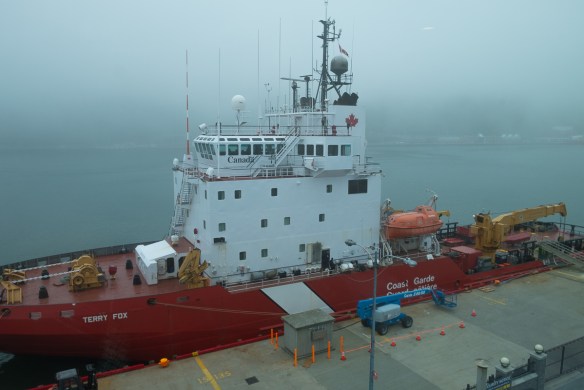If you stand here, your back to the sea, the entire population of North America stretches out in front of you. And there’s nothing behind you until Ireland.
When I read this imaginative description of Cape Spear in a tourism brochure, I decided I had to see what that felt like, to be on the edge of the continent. This most easterly point is only half an hour outside of St. John’s, and we passed several drifting ice bergs driving along the coast road towards the lighthouse.


There, on this blue sky day, perched at the end of the prow-shaped wooden walkway, my inclination is not at all to look towards those North American hordes as it suggests in the tourism quote, but rather to look out to sea – to see what there is to see, maybe some early whales. I spotted an oil platform way out on the horizon (love those binoc’s) and was told by the park ranger that it had been sitting there for about 2 weeks.




This may be the most easterly part of the continent but it’s not exactly the end of the line. Three hundred kilometers further east offshore there’s another small city above the waves:

Hibernia. This off-shore oil platform is called a GBS, Gravity Based Structure, meaning it is actually cemented to the ocean floor 80 meters below. It’s been in operation for over 20 years – other oil platforms in the Grand Banks region are built to float. They are located right in the path of all those icebergs making their way through from Greenland every spring.
Which means, unlike the floating platforms, Hibernia can only stare helplessly at any giant iceberg heading its way. Well, maybe not so helplessly. The engineers built this structure to withstand the impact of a 1 million ton iceberg with no damage and a 6 million ton, estimated to be the outside size of an iceberg that could show up in waters of that depth, with repairable damage.
Plus, the iceberg tracking technology is even better than it was when the structure was first built and any problematic icebergs are dealt with 20 km out, where support vessels circle the iceberg with a giant lasso and tow it off its trajectory and give it a nudge in another direction. Works for the small to medium ones.
So sounds pretty unsinkable. Hmmm.
The supply and support base for the Hibernia and the other floating oil platforms is in St. John’s harbour, a few blocks away from where we stayed.
Day and night the support vessels went back and forth, from base to off-shore oil platform. Each platform always has at least one support ship with it at all times, shuttling supplies and staying close by to provide emergency support as well as any necessary iceberg towing duty in the spring.
The on board platform’s crew, 280 people, work 3 weeks on and 3 weeks off and commute to work by helicopter. Now before you start imagining helicopter riding to work, everybody who works there, everybody who sets foot on the Hibernia has to undergo intensive North Atlantic survival skill training, that includes how to escape from a submerged upside down helicopter in stormy weather. Not everyone passes survival training. If you don’t you can’t work there.
Safety on these big rigs and around the ships that service them is a big deal; there have been many accidents to learn from. The capsize of the Ocean Ranger platform in a storm with all 84 lives lost, was another of many tragedies of the sea the Newfoundlanders have endured over the years. The offshore oil industry has its share of accidents – I was reminded of that when I heard last week of 2 Norwegian oil platform workers who were killed recently during a safety drill.






Off-shore oil platform support ships – coming and going, day and night, all weather
I love the accessibility of the port of St. John’s, open to view along the waterfront road and pedestrian walkway, separated by chain link fence only.



So where does all this fascination with ships come from?
I have a persistent memory as a child, being taken by my friend Shauna Kamichick’s father one Sunday morning down to the docks in Montreal, where he took us for a tour on board two ships. One was Italian and one was Scandinavian and I remember the difference between them. Think lived-in vs. spic and span, exuberant vs. reserved, pets vs. none, morning wine vs not. They were both kind to us though and both were fascinating.
I have no idea how Mr. Kamichick came to be on board with a couple of little girls, what his work was for instance or any of that – I was a child. But I always remember bits of that day, especially when I am around ships. A very rare memory from that time. Maybe that’s where this attraction to watching ships all started.
Of course, it could also be hard wired.

Dad – Ship’s Engineer 
Merchant Marines
